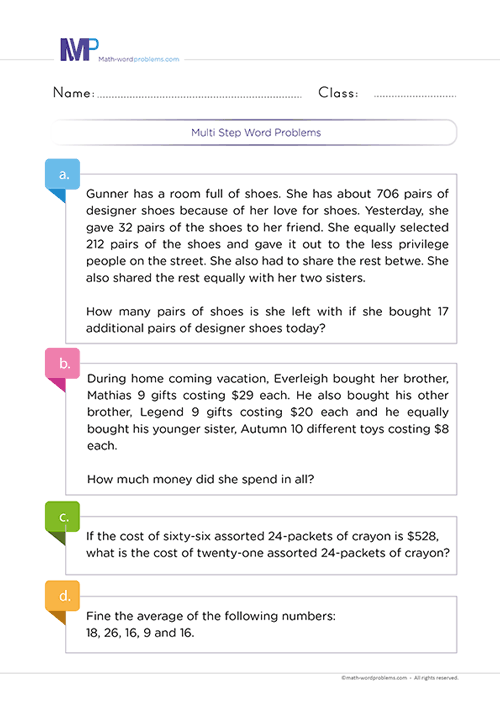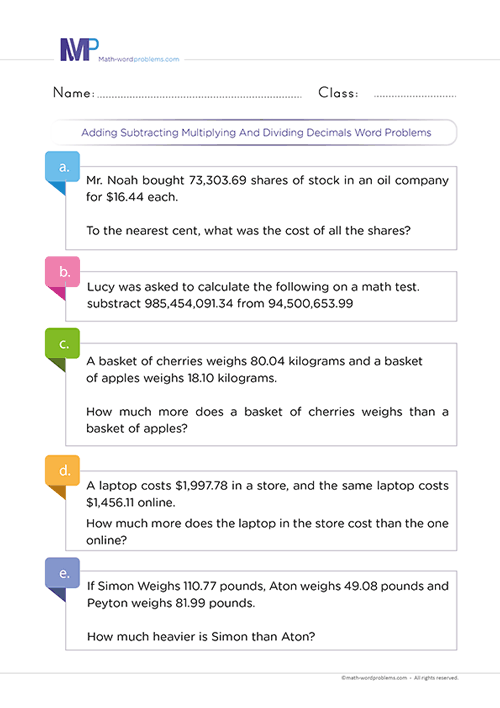 How to perform multi-step word problems
How to perform multi-step word problems
Improve your 5th grader's math knowledge on how to perform multi-step word problems with this powerful, straightforward step-by-step guide.
Now, we all can testify that word problems are always challenging, i.e., the fact that kids will have to identify keywords, separate relevant from irrelevant information, and even sometimes sort through extra information is a challenging experience.
Then, Multi-step word problems are even more challenging because you need to put in extra effort in interpreting the many steps needed to solve such problems. It is, however, for this reason that we have designed this super fantastic resource for 5th graders to practice and be familiar with the procedure to perform multi-step word problems in correct and perfect order.
Moreover, these steps will sort out all the problems that kids face when encountering complicated multi-step word problems.
Steps to solve multi-step word problems
While going through these steps to solve multi-step word problems, you'll realize that we have incorporated two fundamental instructional methods (schema-based instruction and general strategy instruction) into one so that kids can gain mastery of solving multi-step word problems at their fingertips.
With schema-based instruction, you need to identify the problem type, create a mental representation of the problem/ write it down in your own words, provide a math equation for the problem, then solve it accurately.
The general strategy follows the approach of reading the question very well to understand it, come up with a solution plan, provide a math equation, and then solve it.
However, we have incorporated these two methods into one for kids' to follow a one and unique solving process, i.e., they'll be able to identify any complex multi-step word problems.
In line with this, we have added some exciting and fun examples for kids to practice on.
Step 1: IDENTIFY THE PROBLEM
To identify the problem, look for what the problem wants you to do by reading it between the lines. Also, figure out the vital numbers and keywords in the word problem.
As you know, multi-step word problems always consist of more than one operation in a given problem.
Below are some keywords of the most important four operations in mathematics.
- Addition keywords include; add, plus, more, total, increase, together, Altogether, combined, and, sum, grow, join, both, in all, how many in all, how much, spend in all, etc.
- Then, with subtraction, you'll find keywords such as: - less, minus, take away, left, decrease, difference, fewer, deduct, remain, change, how many more, left over, less than, how much longer/shorter, how much more, fewer than, discount, etc.
- With multiplication, you'll find keywords like: - times, multiplied by, product, product of, factor, of, multiply, times, multiple, double, triple, groups, by, twice, area, equal groups, every, in all, total, increased by, as much, each, lots of, groups of, per, etc.
- Lastly, here are some division Keywords: - divide, half, evenly, every, per, parts, out of, quotient of, ratio of, how many in each, equal parts, cut up, average, as much, etc.
Note: One key Element for learners to understand is that they should not always rely on keywords alone. That is to say; the same keyword can have different meanings in different word problems.
For this reason, we reiterate on the importance of reading the question very carefully to understand the situation that the word problem is describing, then figure out exactly which operation to use
Step 2: STRATEGIZE OR GATHER RELEVANT INFORMATION
How will you solve or tackle the problem?
One key thing you should remember is that each word problem may require a different format. So, these key points below will help kids to solve any format however it comes accurately.
- As mentioned above, from the keyword(s) in the word problem, you will know if you need to perform one, two, three, or all of the mathematical operations in a single question/problem.
- Since you must not count only on keywords, always try to understand the situation that the problem is describing.
- Furthermore, after identifying the keywords and the operation(s) you are supposed to perform, construct short sentences to represent the given word problem.
Step 3: CREATE THE EQUATION
Here, you need to write down numerical equation(s) representing the information in the word problem.
Step 4: PROVIDE A SOLUTION
From Step 3 above, perform one, two, three, or all of the mathematical operations. Remember to include the unit of measurement in your final result.
Step 5: CHECK YOUR WORK
Finally, check if your answer makes sense. For example, use common sense i.e., Estimate the answer and see if it is close to what you expected. However, if the answer is not what you expect, go back to step one and start all over again.
Examples on how to solve multi-step word problems for grade 5
Example one
Step 1:The important numbers are $6,523, $25,631, $231, $45,236, and... The keywords in the word problem are "thrice" and "how much."
Step 2:Now, how will you solve the problem? Since this is a multi-step word problem, let's interpret each keyword accordingly.
- "She also spent twice the amount of money she used on food in buying designer shoes" calls for a multiplication operation (first operation).
- "How much money did she have in her credit card initially" calls for an addition operation (second operation).
Next, after identifying the keywords and the operations you will perform, form short sentences to represent the given word problem.
- Amount of money she spent on her wedding dress = $6,523
- Amount of money she spent on food = $25,631
- Amount of money she spent on her make-up = $231
- The amount of money she spent on designer shoes = thrice the money she spent on food
- The amount of money she spent in all = the amount of money she spent on her wedding dress + the amount of money spent on food + the amount of money spent on her make-up + the amount of money spent on designer shoes.
- Amount of money left in her credit card =?
- Therefore, the initial amount of money in her credit card = the amount of money she spent in all + the amount of money left in her credit card
Step 3:Now, write down all the numerical equations for each bolded sentence in step 2 above to solve this word problem:
- $25,631 × 3 = ?
- $6,523 + $25,631 + $231 + $76,893 = ?
- $109,278 + $45,236 = ?
Step 4: From step 3 above, you need to perform two operations in this problem, i.e., Addition and Multiplication. Now, go ahead and solve the numerical equations above using these operations. Remember to include the unit of measurement in your final answer.
- $25,631 × 3 = $76,893 → answer to the first bolded statement in step 2
- $6,523 + $25,631 + $231 + $76,893 = $109,278 → answer to the second bolded statement in step 2, which is also equal to the amount of money left in her credit card
- $109,278 + $45,236 = $154,514 → answer to the last bolded statement in step 2, which is the final answer to the problem.
So, she had $154,514 in her credit card initially.
Step 5:Finally, check if your answer makes sense. For instance, estimate the answer and see if it is close to what you expected. However, if the answer is not what you expected, go back to step one and start all over again.
Example Two
Step 1:The important numbers are 752, 327, and 25. Also, the keywords in the word problem are "equally" and "each."
Step 2:Now, how will you solve the problem? Since this is a multi-step word problem, let's interpret each keyword accordingly.
- "He kept 327 and distributed the rest…" entails that you need to perform a subtraction operation.
- "How many stickers did each student get?" calls for a division operation.
Next, after identifying the keywords and the operations you will perform, form short sentences to represent the given word problem.
- Number of stickers that the teacher had = 752
- Number of stickers that he kept for himself = 327
- Number of stickers that he distributed to his students = the number of stickers that the teacher had – the number of stickers that he kept for himself
- The number of students he distributed the stickers to = 25
- Therefore, the number of stickers each student got = the number of stickers that he distributed to his students ÷ the number of students he distributed the stickers to
Step 3:Now, write down all the numerical equations for each bolded sentence in step 2 above to solve this word problem:
752 – 327 = ?
You will realize that to formulate the next math equation (the second bolded numerical expression), you need the answer to the above equation (the first bolded expression).
So, before we move on to step 4, we must provide the solution to the math equation above.
Let's use the column method of subtraction to solve this equation.
So, the mathematical equation to the second bolded statement in step 2 above will be:
425 ÷ 25 = ?
Step 4: From step 3 You see that, from step 3 above,
- You need to perform two operations in this problem; subtraction and division. But you have already performed the subtraction operation.
- Now, go ahead and solve the numerical equation above
- Remember to include the unit of measurement in the final answer.
425 ÷ 25 = 17
So, each student got 17 stickers.
Step 5:Finally, check if your answer makes sense. For instance, estimate the answer and see if it is close to what you expected. However, if the answer is not what you expected, go back to step one and start all over again.






